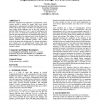Free Online Productivity Tools
i2Speak
i2Symbol
i2OCR
iTex2Img
iWeb2Print
iWeb2Shot
i2Type
iPdf2Split
iPdf2Merge
i2Bopomofo
i2Arabic
i2Style
i2Image
i2PDF
iLatex2Rtf
Sci2ools
ASSETS
2010
ACM
2010
ACM
Utterance-based systems: organization and design of AAC interfaces
Electronic Augmented and Alternative Communication (AAC) systems provide a method for people with severe speech impairments to communicate by selecting what they desire to say, and have the system "speak" it for them. AAC interfaces present many unique design challenges due to the wide variation of physical ability among AAC users. A goal of technological aids for AAC users is to bridge the communication gap, increasing both rate and comprehensiveness of communication [2]. Here we focus on the design of an utterance-based system developed for literate, high-functioning adults interacting in public goaldirected situations with unfamiliar partners. This research involves the design and development of a coherent and intuitive AAC interface for an utterance-based system built upon theoretical evidence and observation of commercial-grade AAC interface software. Categories and Subject Descriptors K.4.2 [Computers and Society]: Social Issues ---Assistive technologies for persons wi...
| Added | 12 May 2011 |
| Updated | 12 May 2011 |
| Type | Journal |
| Year | 2010 |
| Where | ASSETS |
| Authors | Timothy J. Walsh |
Comments (0)

